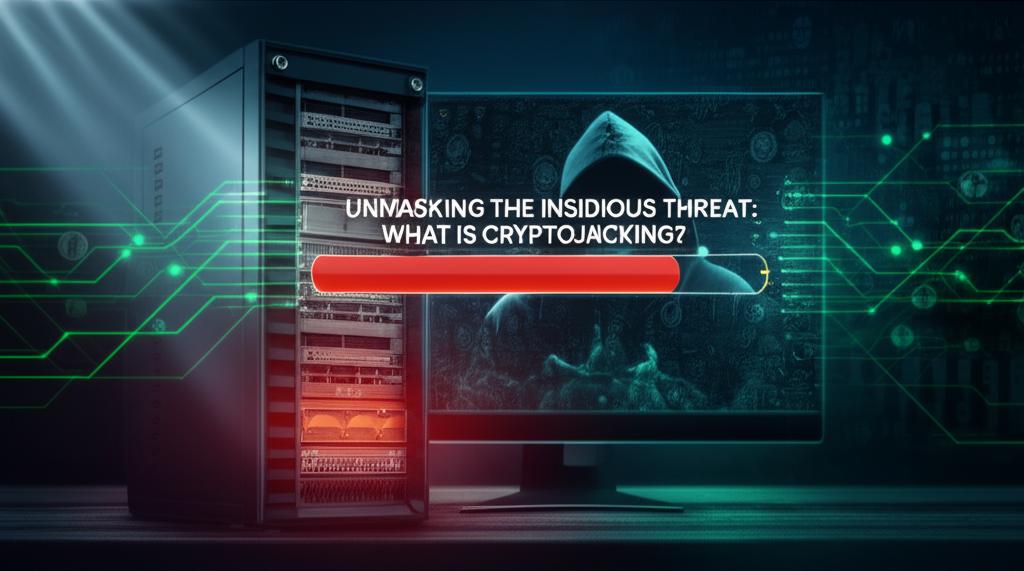Unmasking the Insidious Threat: What is Cryptojacking?
In the evolving landscape of cybercrime, a particularly stealthy and insidious threat has emerged: cryptojacking. Unlike ransomware, which announces its presence, cryptojacking operates in the shadows, silently hijacking your device’s computing power to mine cryptocurrencies without your knowledge or consent. This illicit activity can affect individuals, businesses, and even large organizations, leading to significant performance degradation and increased operational costs.
How Does Cryptojacking Work?
The core mechanism of cryptojacking involves an attacker gaining unauthorized control over a victim’s CPU or GPU resources. This is typically achieved through one of two primary methods:
- Malware-based Cryptojacking: The attacker tricks the victim into loading a malicious code onto their computer. This often happens via phishing emails containing infected links, compromised websites, or legitimate software bundled with hidden cryptomining scripts. Once installed, the malware runs in the background, continuously mining cryptocurrency.
- Browser-based Cryptojacking: This method is even more subtle. Attackers embed a malicious JavaScript code into a website or online advertisement. When a user visits the compromised site or interacts with the ad, the script automatically begins mining cryptocurrency using the visitor’s browser. This form of cryptojacking often ceases once the browser tab is closed, but persistent attacks can employ malicious browser extensions or inject code into legitimate sites.
Regardless of the method, the goal of the cryptojacker is the same: to leverage the victim’s resources to generate digital currency, primarily privacy-focused coins like Monero, which are harder to trace.
Types of Cryptojacking
While the ‘how’ mostly covers the types, it’s worth categorizing them distinctly:
- Persistent Cryptojacking: Involves the installation of malware that ensures continuous mining, even after the user leaves the compromised website or restarts their device. This is the more severe form of cryptojacking.
- Non-Persistent Cryptojacking: Typically browser-based, where the mining activity only lasts as long as the user has the malicious website or tab open. While less impactful in isolation, frequent exposure can still take a toll.
Signs You Might Be a Victim of Cryptojacking
Because cryptojacking is designed to be clandestine, it often goes unnoticed. However, there are several tell-tale signs that your device might be compromised:
- Slowed Performance: Your computer or smartphone becomes unusually sluggish, and applications take longer to load or respond.
- Overheating Device: Excessive CPU/GPU usage causes your device to generate more heat, leading to louder fan noise and a physically hot device.
- Increased Energy Consumption: Higher processing demands translate to more power usage, potentially leading to higher electricity bills for desktop users or rapid battery drain for mobile devices.
- Unusual System Resource Usage: Task Manager (Windows) or Activity Monitor (macOS) shows consistently high CPU usage, even when you’re not running demanding applications.
Impacts of Cryptojacking
The consequences of a cryptojacking attack can range from minor annoyances to significant operational setbacks:
- Performance Degradation: The primary impact is a noticeable slowdown of your device, hindering productivity.
- Hardware Damage: Prolonged overheating due to constant heavy processing can shorten the lifespan of your CPU, GPU, and other components.
- Increased Costs: Higher electricity bills for individuals and increased cloud resource consumption costs for businesses.
- Security Risks: The methods used to deploy cryptojacking malware can also open doors for other, more damaging forms of cyberattacks.
How to Prevent Cryptojacking
Protecting yourself from this digital menace requires a multi-layered approach to cybersecurity:
- Use Ad Blockers and Anti-Cryptomining Extensions: Many popular ad blockers (e.g., uBlock Origin, AdBlock Plus) can also block known cryptojacking scripts. Specialized browser extensions (e.g., NoCoin, MinerBlock) are designed specifically for this purpose.
- Keep Software Updated: Regularly update your operating system, web browser, and all applications. Patches often fix vulnerabilities that cryptojackers exploit.
- Employ Robust Antivirus/Anti-Malware Software: A reputable security suite can detect and block cryptojacking malware before it takes root.
- Be Wary of Suspicious Links and Downloads: Exercise caution with unsolicited emails, suspicious links, and untrusted file downloads.
- Monitor System Performance: Periodically check your CPU usage using built-in system tools. Unusual spikes can indicate a problem.
- Implement Strong Network Security (for Organizations): Use firewalls, intrusion detection systems, and network monitoring to identify and block cryptojacking attempts at the perimeter.
Conclusion
Cryptojacking represents a clandestine yet potent threat in the digital realm. Its ability to silently exploit your computing resources makes it particularly dangerous, as victims often remain unaware until significant performance issues arise. By understanding how it works and implementing proactive security measures, you can safeguard your devices and data from this insidious form of cyber exploitation. Vigilance and robust cybersecurity practices are your best defense against the hidden drains of cryptojacking.







